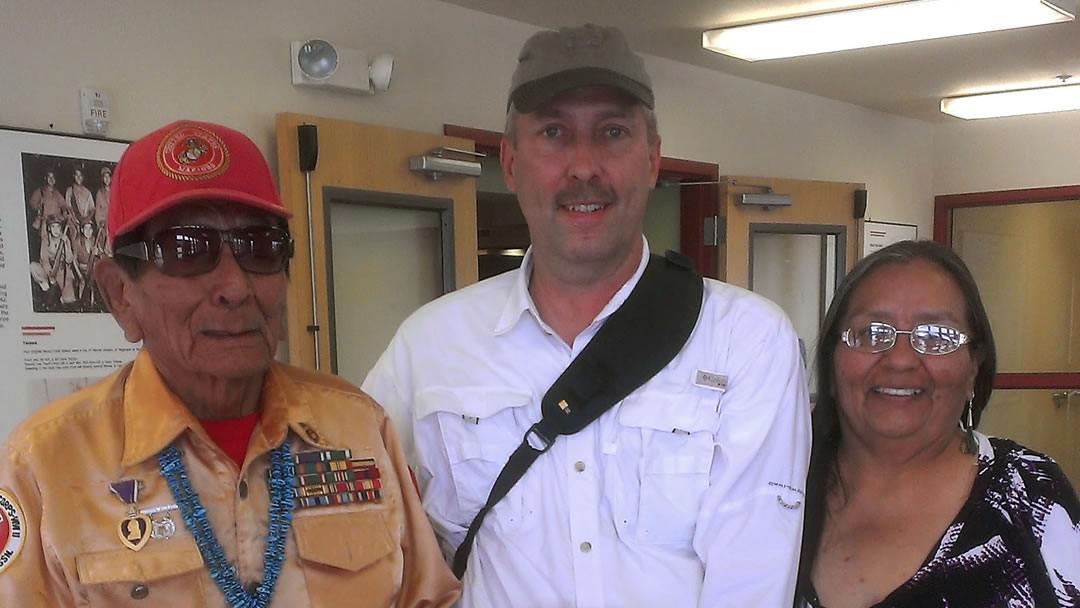
Did you know that August 14 was designated as National Navajo Code Talkers Day by President Ronald Reagan in 1982?
I can honestly say that one, if not the greatest achievement in my decade-plus as a tour director, is to say that I have had the distinct pleasure of meeting three different Navajo Code Talkers. In fact, I remember on one tour, arriving at Monument Valley and being told by security that the bus I just watched rollout, had the last surviving member of the original 29 Navajo Code Talkers on it. I was seriously considering asking my coach driver to turn around and chase that bus down!
I mean, how often does one person get to meet real life, in the flesh and blood, war heroes? Especially ones who never had the proper recognition from a nation that certainly owes their gratitude and maybe even their freedom to what they did for us in World War Two! Half joking, I always tell guests that if it were not for them, we may be speaking Japanese right now!
Navajo Code Talker?
What always amazed me, and even shamed me was that when visiting the Navajo Nation (Monument Valley) and I would talk of the Navajo Code Talkers, most of my American tour guests were clueless to what and who I was talking about. Meanwhile, many of my foreign guests were anxious to hear more about them. How can they know more about this part of our history than we Americans??
In fact, on my first Albuquerque Balloon Fiesta tour, I had one British guest who served in the US Army, did the proper salute to three of them at a booth before they autographed the book he just bought.
(And PLEASE do not take the Nicholas Cage Movie “WindTalkers” as any real characterization of who these brave men really were or the positions they were put in….)
Although President Reagan was the first US President to officially recognize and award the Navajo Code Talkers for their efforts and bravery in helping us win World War 2, by the time of the announcement, over half the Code Talkers had passed away, and only a few of the remaining members were healthy enough to travel to Washington for the award ceremony.
- Book: Samuel Holiday – Under The Eagle
- Documentary: In Search of History – Navajo Code Talkers (History Channel)
- Movie: Windtalker
In meeting these gentlemen, I noticed no anger at being ignored by our government after their service. No remorse in doing what they did for an ungrateful nation or for maintaining their silence all these years. Like many WW2 Vets, they talked about the life they built after returning from the war and doing what needed to be done to continue preserving what was left of their culture. They accepted their fate and moved on with life.
What was interesting in what these men had to say and what they said in their various books, was that they joined the US Military, not because of their loyalty or feelings of needing to honor our country.
It was just the opposite. They were not going to war to defend us, but to push back against an enemy that did a sneak attack. The attack on Pearl Harbor was supposedly unprovoked. So the Navajo wanted to push back against that. The “Your enemy is my enemy” theory.
So even before the Codetalker idea was created, Navajo warriors were joining our military and fighting overseas.
Who were the Navajo Codetalkers?
During World War Two, the Japanese military was slaughtering us because they were able to decipher our secret codes as quickly as we transmitted them. An idea was floated. To recruit young men from the Navajo Tribe near Flagstaff Arizona, the very people our nation had been trying to exterminate for over 100 years and use them as code talkers.
The Navajo language had never been a written language. we had never mixed war prisons with them as we did other tribes around the United States. Plus they did not have words for things were doing in the war, like flying planes or dropping bombs. So they had to use references like birds droppings for planes dropping bombs.
One of the key selling points was that with sending traditional coeds, it could take hours or days for the receiving troops to decode and get the message out to the troops. With the Navajo, codetalkers could send a message from one codetalker to another and it was deciphered immediately.
The Japanese would have no idea what the jibberish they were hearing when they picked up the transmissions. Plus this was a top-secret project that only those who needed to know. So even most of the other marines would not know who these men were or why they were there.
The higher up’s in US Military had fought the idea of adding another race into the troop mix as they were just adjusting to allowing African Americans to join the battles. So they set up a test of 30 Navajo men who would have to pass Marine Basic Training before they could go to the classes to learn the art of code talking.
It was an all-or-nothing deal. All 30 would have to pass marine basic training, the toughest basic training of the US Military. If one failed, they all were to be sent home. On the day they were to leave, one came down with chickenpox. The Military agreed that was not of his doing, so they let the other 29 go ahead.
Now think about this. You live in one of the most remote parts of America, you run everywhere to do everything. You are working from sunup to sundown. So basic training for these guys was a cakewalk, plus they were well fed every day! Bonus in their minds! That caused a few other Marines to grumble about the “redskins” they had to train with!
Contrary to movies like Windtalker, they were never in danger of being executed if discovered. Or that they were always operating safely in the back of the pack. They fought on the frontlines in some of the fiercest battles we had with the Japanese, going cave to cave, island to island. To say they saved our backsides would be an understatement…
And that’s where the sad part comes in. Once they returned home, they were not heroes, they did not get to enjoy the benefits of being a war hero or getting any kind of priority in getting government jobs. Their roles as Codetalkers were classified and they were not allowed to talk about it. Many just went back to their tribal lands and tried to live their life out as they did before the war.
In the end, Native American men from 33 different tribes were used for the program. It is the Navajo and the Navajo Nation that provided the first recruits as well as a majority of the men for the program.

Be the first to comment